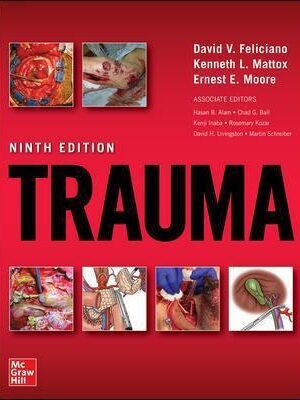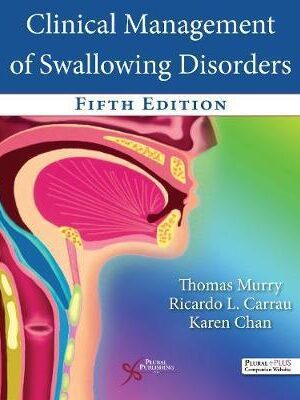Clinical Management of Swallowing Disorders 5th Edition
Clinical Management of Swallowing Disorders Fifth Edition:
New to the Fifth Edition
- New chapter on the aging population!
- The Anatomy and Physiology chapter has been thoroughly updated and 15 beautiful, new full color illustrations have been added
- More images and enhanced figures, including additional FEES and fluoroscopy video studies of swallowing disorders in head and neck cancer and stroke patients
- Many new references, easy-to-read tables, and treatment hints
- Information on pediatric feeding and swallowing has been updated and expanded
- Evidence-based practice methods have been updated
- Content has been edited to be more concise, applicable, and reader friendly
The text features numerous pedagogical aids to reinforce student understanding
- Case study inserts in many chapters and 9 extended case studies in the final chapter
- 32 videos
- Discussion questions and answers for each chapter
- Bolded and boxed key terms throughout with an end-of-book glossary
- Clinical tips, clinician s roles, areas of emphasis, and key learning points highlighted in boxes throughout the chapters
- 8 appendices featuring helpful tests and tools for clinicians
- NEW full clinical swallowing examination record form included in appendix
- Access to ancillary materials on a PluralPlus companion website, including instructor lecture slides, downloadable versions of the appendices, and PowerPoint flashcards
Additional ISBNs:
∗ eText ISBN: 1635502551, 978-1635502558, 9781635502558
- See additional information on the Amazon.
More Details
Cover
Title Page
Copyright
Contents
Preface
Acknowledgments
Video List
Chapter 1. Introduction to and Epidemiology of Swallowing Disorders
Introduction
Need for Early Intervention
Epidemiology
Summary
Discussion Questions
Study Questions
References
Chapter 2. Anatomy and Physiology of the Swallowing Mechanism
Introduction
Central Nervous System
Peripheral Nervous System
Anatomy of the Swallowing Mechanism
The Normal Swallow
Cranial Nerves Involved in Swallowing
Sphincters
Central Neural Control of Swallowing
Respiration and Deglutition
Summary
Discussion Questions
Study Questions
References
Chapter 3. Swallowing Disorders Arising From Neurologic Disorders and Other Diseases
Introduction
Neurologic Disorders
Swallowing Disorders Found in Critical Care Patients
Esophageal Swallowing Disorders
Infectious Diseases
Medications and Swallowing Disorders
Swallowing Disorders Following Radiation Therapy
Autoimmune Disorders and Diseases
Summary
Discussion Questions
Study Questions
References
Chapter 4. Swallowing Disorders Following Surgical Treatments
Introduction
Anterior Cervical Spine Surgery
Neoplasms
Head and Neck Surgery
Skull Base Surgery
Tracheotomy
Zenker Diverticulum
Summary
Discussion Questions
Study Questions
References
Chapter 5. Clinical Evaluation of Swallowing Disorders
Introduction
Evidence-Based Practice
Multidisciplinary Dysphagia Team
Swallowing Screening
Clinical Swallow Evaluation
Silent Aspiration and the Clinical Swallow Examination
Summary
Discussion Questions
Study Questions
References
Chapter 6. Instrumental Evaluation of Swallowing Disorders
Introduction
Flexible Endoscopic Evaluation of Swallowing
Modified Barium Swallow
Modified Barium Swallow, Flexible Endoscopic Evaluation of Swallowing, and Silent Aspiration
Manometry and High-Resolution Manometry
Tongue Pressure/Strength Measurement
Other Instrumental Tests Associated With Swallowing Disorders
Summary
Discussion Questions
Study Questions
References
Chapter 7. Treatment of Swallowing Disorders
Introduction
Evidence-Based Practice
Multidisciplinary Approach to Swallowing Therapy
Oral Hygiene
Compensatory Swallowing Therapy
Rehabilitative Swallowing Therapy
Preventive Swallowing Therapy for Head and Neck Cancer Survivors
Other Swallowing Treatment Methods
Summary
Discussion Questions
Study Questions
References
Chapter 8. Nutrition and Diets
Introduction
Dietitian and Dysphagia
Properties of Liquids and Foods
Oral Nutrition and Dysphagia Diets
Nonoral Diets
Malnutrition and Dehydration
Summary
Discussion Question
Study Questions
References
Chapter 9. Swallowing in the Aging Population
Introduction
Aging Process Related to Swallowing
Changes in Swallowing
Dementia
Feeding Assistance
Nutrition in the Aging Population
Ethical Considerations
Summary
Discussion Question
Study Questions
References
Chapter 10. Pediatric Dysphagia: Assessment of Disorders of Swallowing and Feeding
Introduction
Definition
Etiology
Epidemiology
Anatomy of Swallowing and Feeding
Physiology of Swallowing and Feeding
Coordination of Apnea in Pediatric Swallowing
Classification of Dysphagia
Diagnosis
Assessment of Early Reflexes
Summary
Discussion Questions
Study Questions
References
Chapter 11. Treatment of Feeding and Swallowing Disorders in Infants and Children
Introduction
Pediatric Feeding Disorders
Feeding and Swallowing Behaviors
Treatment for Specific Disorders
Options and Considerations in the Treatment of Feeding Disorders in Infants and Children
Nonoral Feeding
Additional Factors in Infant Feeding and Swallowing
Summary
Discussion Questions
Study Questions
References
Chapter 12. Surgical Treatment and Prosthetic Management of Swallowing Disorders
Introduction
Rehabilitative Surgical Procedures
Palliative Surgical Procedures
Surgical Conclusions
Prosthetics
Prosthetics Conclusions
Summary
Discussion
Study Questions
References
Chapter 13. Case Studies
Introduction
Diagnosis
Instrumentation
Personnel
Facilities
Case Studies From Voice and Swallowing Centers
Summary
Discussion Questions
Study Questions
References
Glossary
Appendix 1. Reflux Symptom Index (RSI)
Appendix 2. Reflux Finding Score (RFS)
Appendix 3. Burke Dysphagia Screening Test
Appendix 4. The MD Anderson Dysphagia Inventory
Appendix 5. Eating Assessment Tool (EAT-10)
Appendix 6. Dysphagia Handicap Index (DHI)
Appendix 7. Voice Handicap Index-10 (VHI-10)
Appendix 8. Clinical Swallowing Examination Sample Form
Answers to Study Questions
Index




























 Dentistry
Dentistry
Reviews
There are no reviews yet.